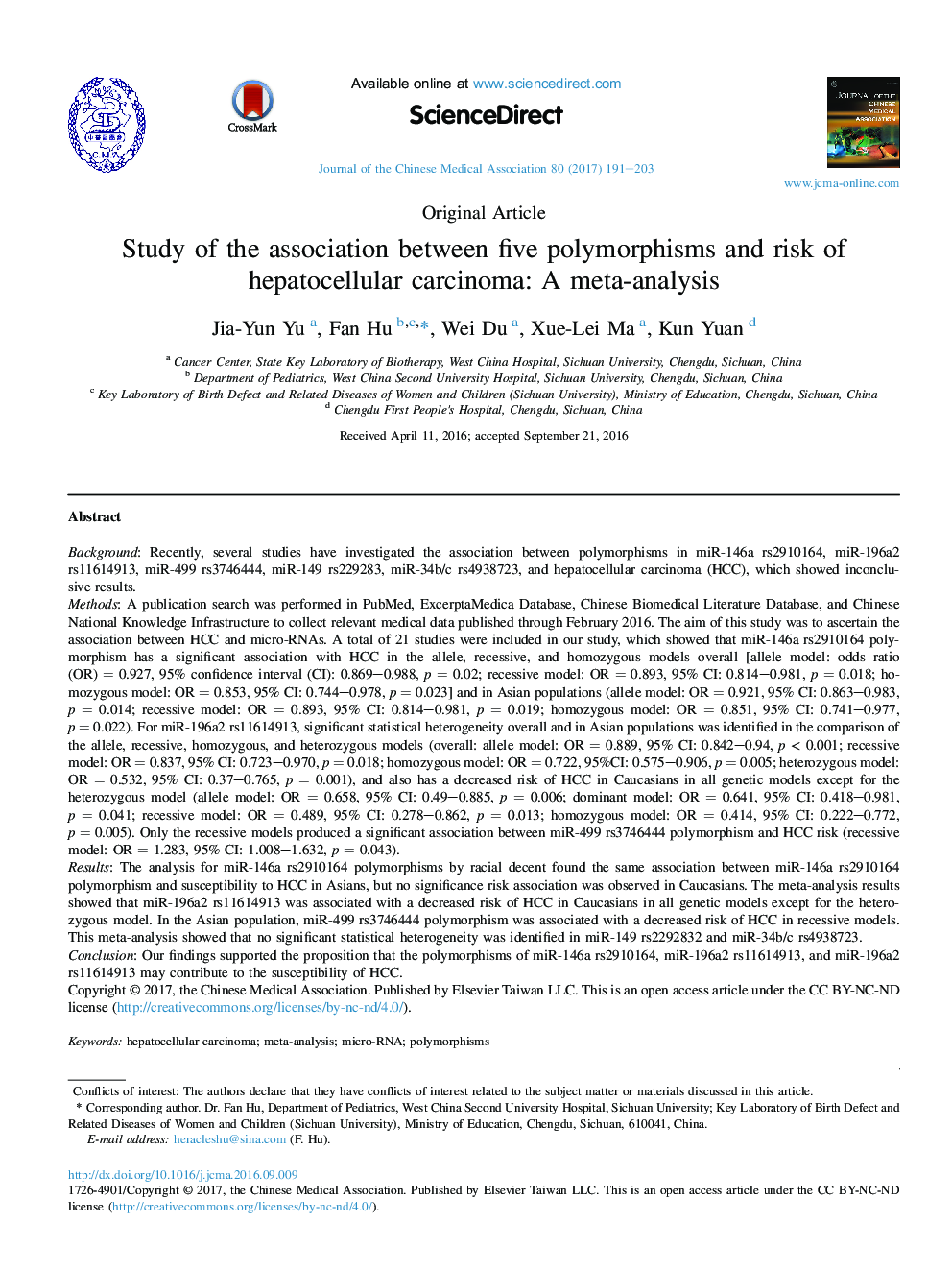| Article ID | Journal | Published Year | Pages | File Type |
|---|---|---|---|---|
| 5679727 | Journal of the Chinese Medical Association | 2017 | 13 Pages |
BackgroundRecently, several studies have investigated the association between polymorphisms in miR-146a rs2910164, miR-196a2 rs11614913, miR-499 rs3746444, miR-149 rs229283, miR-34b/c rs4938723, and hepatocellular carcinoma (HCC), which showed inconclusive results.MethodsA publication search was performed in PubMed, ExcerptaMedica Database, Chinese Biomedical Literature Database, and Chinese National Knowledge Infrastructure to collect relevant medical data published through February 2016. The aim of this study was to ascertain the association between HCC and micro-RNAs. A total of 21 studies were included in our study, which showed that miR-146a rs2910164 polymorphism has a significant association with HCC in the allele, recessive, and homozygous models overall [allele model: odds ratio (OR) = 0.927, 95% confidence interval (CI): 0.869-0.988, p = 0.02; recessive model: OR = 0.893, 95% CI: 0.814-0.981, p = 0.018; homozygous model: OR = 0.853, 95% CI: 0.744-0.978, p = 0.023] and in Asian populations (allele model: OR = 0.921, 95% CI: 0.863-0.983, p = 0.014; recessive model: OR = 0.893, 95% CI: 0.814-0.981, p = 0.019; homozygous model: OR = 0.851, 95% CI: 0.741-0.977, p = 0.022). For miR-196a2 rs11614913, significant statistical heterogeneity overall and in Asian populations was identified in the comparison of the allele, recessive, homozygous, and heterozygous models (overall: allele model: OR = 0.889, 95% CI: 0.842-0.94, p < 0.001; recessive model: OR = 0.837, 95% CI: 0.723-0.970, p = 0.018; homozygous model: OR = 0.722, 95%CI: 0.575-0.906, p = 0.005; heterozygous model: OR = 0.532, 95% CI: 0.37-0.765, p = 0.001), and also has a decreased risk of HCC in Caucasians in all genetic models except for the heterozygous model (allele model: OR = 0.658, 95% CI: 0.49-0.885, p = 0.006; dominant model: OR = 0.641, 95% CI: 0.418-0.981, p = 0.041; recessive model: OR = 0.489, 95% CI: 0.278-0.862, p = 0.013; homozygous model: OR = 0.414, 95% CI: 0.222-0.772, p = 0.005). Only the recessive models produced a significant association between miR-499 rs3746444 polymorphism and HCC risk (recessive model: OR = 1.283, 95% CI: 1.008-1.632, p = 0.043).ResultsThe analysis for miR-146a rs2910164 polymorphisms by racial decent found the same association between miR-146a rs2910164 polymorphism and susceptibility to HCC in Asians, but no significance risk association was observed in Caucasians. The meta-analysis results showed that miR-196a2 rs11614913 was associated with a decreased risk of HCC in Caucasians in all genetic models except for the heterozygous model. In the Asian population, miR-499 rs3746444 polymorphism was associated with a decreased risk of HCC in recessive models. This meta-analysis showed that no significant statistical heterogeneity was identified in miR-149 rs2292832 and miR-34b/c rs4938723.ConclusionOur findings supported the proposition that the polymorphisms of miR-146a rs2910164, miR-196a2 rs11614913, and miR-196a2 rs11614913 may contribute to the susceptibility of HCC.
